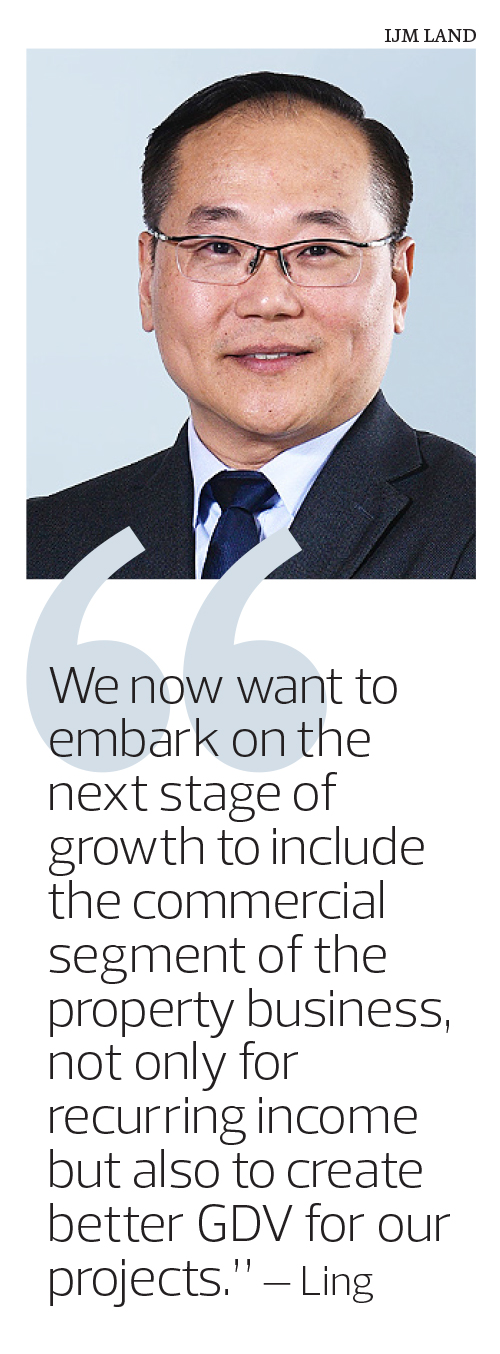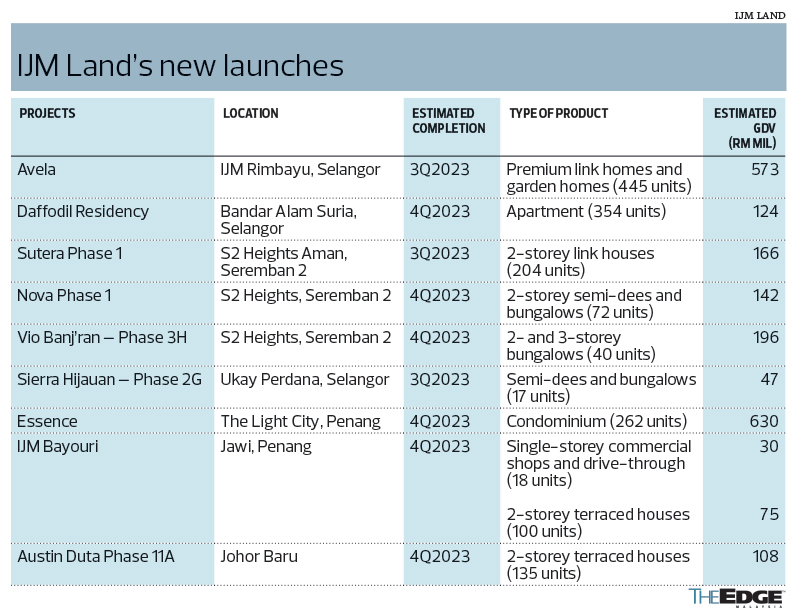This article first appeared in The Edge Malaysia Weekly on August 28, 2023 - September 3, 2023
IJM Land Bhd, the property development arm of IJM Corp Bhd, is joining a growing number of property companies seeking to diversify their risk from pure residential development projects for sale to include alternative sources of revenue from recurring income properties.
This follows two years of the Covid-19 pandemic-fuelled slowdown in the housing market that saw many property developers face project delays and a drop in sales.
IJM Land is now seeking to diversify its portfolio into investment properties such as malls, hotels, offices as well as wellness centres that are better able to offer stable recurring income, which home sales cannot.
IJM Land chief operating officer Datuk Tony Ling Thou Lung says the group is looking at “integrated developments” that will include commercial projects at its existing projects.
“In the past, IJM Land mainly focused on township development as seen in Rimbayu and Seremban 2, which focus [primarily] on residential properties,” he tells The Edge in an interview.
“We now want to embark on the next stage of growth to include the commercial segment of the property business, not only for recurring income but also to create better gross development value (GDV) for our projects,” he says.
“The first phase of the integrated development is to include the commercial component, followed by the second phase where IJM Land is looking to include wellness and medical elements such as nursing homes and assisted living.”
Ling points out that the pandemic has brought about a shift in homebuyers’ preference, where they now tend to opt for properties with well-connected ecosystems. “There has been a change in lifestyle. It is not just about buying properties, but people want a place where they can work, live and play without the need to travel. This is especially so with the hybrid working arrangements that many companies are taking on.”
Ling spent more than 20 years of his career focusing on integrated development for property projects that include offices and commercial, residential and retail components. He was formerly the executive vice-president at S P Setia Bhd, which is the developer of the Kuala Lumpur Eco City and part of a Malaysian consortium that developed the Battersea Power Station in the UK — both of which are integrated developments.
Bullish on property outlook
IJM Land is a wholly-owned subsidiary of IJM Corp. In 2014, IJM Corp privatised IJM Land in a deal worth almost RM2 billion.
The privatisation was a fruitful one for IJM Corp in enhancing its earnings over the years. Its net profit for the financial year ended March 31, 2014 (FY2014) grew to RM533.23 million from RM193.71 million in FY2012. Revenue nearly doubled to RM2.05 billion from RM1.21 billion during the same period.
In FY2023, its property division accounted for 76% of its pre-tax profit, amid weakness in its construction and infrastructure businesses.
IJM Land, which has a land bank of 4,497 acres with an estimated GDV of RM46 billion, has established a foothold in prominent locations across Penang, Kuala Lumpur, Selangor, Negeri Sembilan, Johor, Sabah and Sarawak. It is also undertaking projects abroad in places such as central London in the UK.
According to IJM Corp’s annual report 2023, the group achieved record property sales of RM2.7 billion in FY2023, up from RM2.5 billion in FY2022.
Its completed inventory has reduced from RM1.15 billion in FY2021 to RM738.15 million in FY2023. As at end-July 2023, the number of unsold completed units has been reduced to RM244 million. Its unbilled sales stood at RM3 billion.
In FY2024, Ling expects the group to maintain its sales momentum, albeit slower at RM2.1 billion.
“This is not due to an expected slowdown in sales. We are making some adjustments to our new launches and plan to launch more projects next year,” he says.
In terms of the outlook on the property market, especially with the higher borrowing costs, Ling remains optimistic that sales for residential properties will remain robust in the next two to three years.
“For residential properties, our new launches are seeing encouraging take-up rates, with landed properties almost fully sold and our high-rise project in Segambut seeing a 90% take-up rate.
“I think developers now are more prudent with their new launches to meet the market demand. That is why we are pushing for integrated development to [offer] better value to our projects,” he says.
Asked if he is concerned about the oversupply of offices as IJM Land builds more commercial spaces, Ling says the demand for office space has stabilised post-pandemic as more people return to work, more businesses expand their operations as well as an increase in foreign direct investments (FDIs) from China, Europe and the US into Malaysia.
“Even though there was an oversupply of offices in the last few years, I feel the market has stabilised.
“During the pandemic, people were downsizing. But now we are seeing a lot of companies expanding their businesses and new companies are coming to Malaysia,” says Ling.
“You probably have seen some offices emptied, but that is not because of oversupply but because some companies relocated to new offices and the old ones are not being repurposed.”
Still, IJM Land is not the only company that is seeking to grow its recurring income. Over the years, other property developers have been taking on such endeavours to reduce their exposure to the volatility in the property market, and it has been a fruitful venture.
Take IOI Properties Group Bhd (IOIPG) and Sunway Bhd, for example. With 7.13 million sq ft in lettable area, IOI Properties’ investment assets raked in over RM160.93 million or 15% of its operating profit for the financial year ended June 30, 2022.
Sunway has 12.5 million sq ft in net lettable area, raking in RM235.79 million or 26% of group profit in FY2022.
For IJM Land, it is only the beginning. For starters, Ling says the group is expected to complete its first mall in Penang Waterfront, with an estimated 1.5 million sq ft in net lettable area, and a convention centre measuring 330,000 sq ft, in the first quarter of 2025. It will also have office towers, two residential towers and a 34-storey hotel within the development. The mixed development dubbed as The Light City Penang is being undertaken via a joint venture with Singapore developer Perennial Holdings.
This is followed by the 58-acre integrated development of Pantai Sentral Park in Bangsar South, Kuala Lumpur, which also features retail, offices, wellness, a park and hotel.
“Pantai Central Park is an ideal location for an integrated development comprising residential towers and commercial buildings. It will be our first development to activate the commercial component. We also have identified our current townships, Rimbayu and Seremban 2, to activate the commercial side,” Ling says.
On plans to take IJM Land public again, he says there are none for now as the group is focusing on developing its investment properties. “After all these, maybe we would look into [initial public offering].”
For this year, he expects IJM Land to launch nine new residential projects with an estimated GDV of RM2.1 billion.
The group is also actively expanding its property projects in the UK to replicate its flagship project Royal Mint Gardens, London, which is already completed.
Building on the success of Royal Mint Gardens, IJM Land has collaborated with Network Rail, which owns, operates and develops Britain’s railway infrastructure in England, Scotland and Wales.
In May, IJM Land announced that through its 51%-owned subsidiary RMS (England) 2 Ltd, it will tie up with Network Rail to explore development opportunities on the land adjacent to the railway and through oversite developments in Network Rail’s portfolio in the UK.
Completed in 2019, Royal Mint Gardens was IJM Land’s first project in London and comprises three condominium blocks of up to 15 storeys, built over two active railway lines.
Constructed over the Dockland Light Railway and cantilevering over a Victorian Network Rail viaduct at Tower Hill Station, the 256 private residential units required the construction of an encapsulation structure over live railway lines.
The partnership this time around will take into consideration sites in Central London and the southeast, which will be developed into mixed-use schemes, residential, commercial or logistics properties.
Ling reckons that it will take a while for the new projects in the UK to come on stream as IJM Land would need to identify the land and sign new agreements for any new projects that it will be taking on. “We need to identify the land first and sign separate agreements for each land.”
Save by subscribing to us for your print and/or digital copy.
P/S: The Edge is also available on Apple's App Store and Android's Google Play.
- Xi's showdown with Li Ka-shing threatens China’s pro-business push
- Tan Kean Soon steps down as T7 Global executive deputy chairman, board says no operational impact
- Company auditor loses RM1.29m to investment scam
- Volvo Car brings back Samuelsson as CEO to steer turnaround
- Perak emerges as Malaysia's No 1 sweet corn producer



